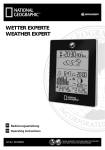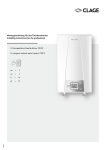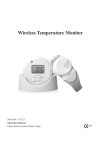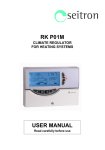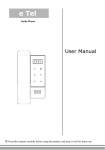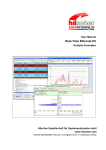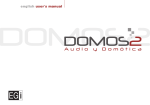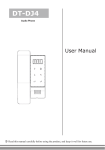Download User Manual Temperature Controller for Automatic Heating and
Transcript
Peltier Controller QC-PC-CO-CH1 User Manual Temperature Controller for Automatic Heating and Cooling Applications Delivery content: 1 Peltier controller QC-PC-CO-CH1 1 Temperature sensor NTC 10KΩ (β=3977K) 1 Potentiometer 10KΩ 1 User manual Technical specifications: -Voltage supply: 12….24VDC/<45mA -Separate driver supply: 3…48VDC -Maximal Peltier current: 20A -Serial Interface: 3,5mm Stereo-Klinke -Temperature range: -40°C - +100°C -Sensitivity: 0,1 °C -Accuracy +/- 0,2 K -P-control characteristic -Control parameter for heating and cooling range separately adjustable -Digital Output definable -Maximal nominal value limit adjustable -Minimal nominal value limit adjustable -Maximal output voltage adjustable -Minimal output voltage adjustable -Detection of sensorial burst and short circuit -Dimensions: Width x Length x Height – 71 mm x 75 mm x 24 mm 1 Proper application of the controller QC-PC-CO-CH1 The Peltier controller QC-PC-CO-CH1 has been developed to actuate Peltier elements. The controller undertakes the control of the temperature in a tempering setup. The temperature range of the controller serves from -40°C to +100°C, while the controller triggers the Peltier element automatically for a suitable heating or cooling. The control parameters are programmable by a serial interface. Via this serial interface either a display with programmable keys or a PC can be linked. The compact construction of the QC-PC-CO-CH1 enables the integration of the controller into a controlling setup, without a significant disturbance of the overall design. The temperature specification either has to be implemented by an external connectable potentiometer or a programmable fixed value. The user has the ability to determine the supply voltage of the controller and the driver supply of the Peltier element separately. Thereby it is possible to trigger optimally nearby all Peltier elements that are available on the market. Furthermore the output supply can be dedicated a minimal and maximal value, while these values can be set for heating and cooling applications differently. Hence with the Quick-Ohm Küpper & Co. GmbH Components – Heat Management – Industry Ceramics www.quick-ohm.de 20140528User Manual English Controller QC-PC-CO-CH1 -1- properties of the Peltier elements is taken into account, that the generable heating power is a multiple of the cooling power. The compact controller QC-PC-CO-CH1 is delivered with preconfigured parameters, which allows an immediate installation into the control without any programming. Please read the user manual thoroughly. If you follow the advice and descriptions, a Peltier controller will stand by your side, which diverse deployability, compactness and enormous performance capability is unreached by any other controller. 2 The principle of the Peltier tempering: The directed current flow through a Peltier element causes plenty of physical processes, which recognizable effect is the spatial displacement of heat energy. The temperature on one side decreases while the temperature on the opposite side increases. This allows the planar attachment of a solid component to heat it up or cool it down purposefully. Compared to conventional gas compressors (e.g. refrigerators) the Peltier element has many advantages. E.g. a noiseless tempering without any hazardous materials, without any movable components and freedom from maintenance is possible. Additionally these devices can be miniaturized in a way that would be unimaginable without the Peltier element. Fig. 2 shows the setup of such a tempering application that should basically always be constructed like that. Fig. 2: Temperature sensor F tempered area Thermal grease or thermal foil etc. Peltier element (printed side above, respectively Red-Right) heatsink Here the basic composition, which is indispensable for the work with Peltier elements, is recognizable. There is an area that should be brought to a certain temperature. This area is equipped with a temperature sensor. On the other side the area is located where the heat gets extracted from or the redundant heat energy is led to in case of a heating and cooling application, respectively. In this second area the temperature is usually not surveilled. To prevent a collapse of the application induced by an excessive removal or feeding of heat, this area is contacted with the environment intensively. That implies that by the usage of a heatsink Quick-Ohm Küpper & Co. GmbH Components – Heat Management – Industry Ceramics www.quick-ohm.de 20140528User Manual English Controller QC-PC-CO-CH1 -2- the surface gets enlarged multiply to establish the needed contact with the ambience. The size of this heatsink and the impeccable bonding between Peltier element and heatsink on the one side and between Peltier element and heating and cooling plate, respectively, on the other are the basic conditions for the determination of the performance of their setup. If you always focus on that basic structure, your results will be successful. Please visit the category Know how in the section of the heat management on our website indicated below to deepen your knowledge. Here you find tips and information in a comprehensible and visualized layout. 3. The electrical setup: The wiring of the single components with the controller requires basic knowledge of electrical engineering and has to be conducted by a qualified person. Fig. 3: Controller QC-PC-CO-CH1 Attention: After switching off the supply voltage internal capacities can hold the voltage for five more minutes. Please make sure that you don’t tough any connection in the circle for that time. Black GND Red Yellow 12..24V Blue Orange U-PE 3…48 VDC - +PE Grey Brown -PE +2,5V Green Control Gnd Poti Poti-Signal +2,5V Sensor signal + Peltier element Supply voltage 12V … 24V White White Temperature sensor NTC 10KΩ β = 3977K Supply voltage Peltier element: Option1 (one power supply): Option2 (two power supplies): Potentiometer 10KΩ Jumper to red Jump minus of both power supplies and lay orange on plus To run the controller, a source of direct current voltage is necessary. Sources in the range of 12VDC to 24VDC are usable. The controller has a separate power input for the supply of the Peltier element available. The zero potential of both voltage sources is merged on the black wire. Thus, the control supply and the Peltier supply can either be separated or alternatively connected. Quick-Ohm Küpper & Co. GmbH Components – Heat Management – Industry Ceramics www.quick-ohm.de 20140528User Manual English Controller QC-PC-CO-CH1 -3- 4. Adjusting the control parameter: The controller QC-PC-CO-CH1 already holds the default parameters in delivery condition which allows the usage without any programming. But it is also possible to change the control parameters to optimize the response characteristics. To adjust these parameters, the controller either has to be connected with the control unit QC-PC-D-CH1 or a computer. The control unit QC-PC-D-CH1 has a display, where the control process can be traced at first sight. By an easily understandable menu all parameters can be adjusted as required. The connection is done by a wire and a 3.5mm jack plug. If the controller should be linked with a computer, a serial connection with a FTDI TTL-232R-5V-AJ connection line has to be established. Do not under any circumstances use other connection cables, because the controller or the computer might get damaged. For a communication among each other the suitable software has to be installed on the machine. One appropriate program is e.g. Tera Term, which can be downloaded on the page http://ttssh2.sourceforge.jp/ for free. Fig. 4: Depiction of the control characteristics Heat voltage 100% Heat parameter maximum Heating 70% Hysteresis Heat parameter minimum heating 20% Heat parameter minimum cooling 0% 0% current temperature Range cooling Range heating Temperature nominal value Heat parameter maximum cooling 100% -100% Cool voltage Parameter list Communikation command [name] SW_VERSION STATUS CONTROL_MODE Description Software version 0 = inaktive 1 = cooling 2 = heating 0 = extern Minimum Maximum min[value] max[value] read only read only read only read only - - Quick-Ohm Küpper & Co. GmbH Components – Heat Management – Industry Ceramics www.quick-ohm.de 20140528User Manual English Controller QC-PC-CO-CH1 -4- Factory setting read only read only Extern R: reading W: writing R R R/W 1 = fix (intern) OUTPUT Output voltage percental SENSOR_TEMP Sensor temperature TEMP_OFFSET Temperature offset SETPOINT Nominal value SETPOINT_FIXED Nominal value at Control mode = 1 SETPOINT_MIN Min.-temperaturlimit SETPOINT_MAX Max.-temperaturelimit HYSTERESIS Hysteresis BANDWIDTH_COOL Bandwith cooling MIN_COOL_OUTP Minimal cooling voltage in % MAX_COOL_OUTP Maximal cooling voltage in % BANDWIDTH_HEAT Bandwidth heating MIN_HEAT_OUTP Minimal heating voltage in % MAX_HEAT_OUTP Maximal heating voltage in % PWM_FREQ PWM-frequency 0 = 1 kHz 1 = 5 kHz 2 = 10 kHz 3 = 15 kHz 4 = 20 kHz 5 = 25 kHz 0.0 100.0 read only R -40.0 -10.0 -40.0 -40.0 +100.0 +10.0 +100.0 +100.0 read only +20.0 R R/W R R/W -40.0 +100.0 -40.0 R/W -40.0 +100.0 +100.0 R/W 0.0 0.1 0.0 1.0 10.0 100.0 1.0 1.0 0.0 R/W R/W R/W 0.0 100.0 100.0 R/W 0.1 0.0 10.0 100.0 1.0 0.0 R/W R/W 0.0 100.0 100.0 R/W 2 R/W 0.0 read only Fig. 4 shows the control behaviour of the controller graphically. By a modification of the parameters the shape of the control curve changes. During the communication via terminal programs and PC-linkage commands have to be send to the controller. Reading and writing commands are distinguished. The commands are listed in the command list. In the last column it is recognizable what kind of command is in use. R represents a readout command while W is a writing command. Commands with the identification R/W can be both read out from the controller and written into it. The following commands are defined: CONNECT Command for the start of communication DISCONNECT Command for the termination of the communication GET Command for the readout of the following values: Current temperature; nominal temperature; control mode; Control state and current output voltage in % GET [name] Command to readout the single values SET [name] [value] Command to overwrite the single values Quick-Ohm Küpper & Co. GmbH Components – Heat Management – Industry Ceramics www.quick-ohm.de 20140528User Manual English Controller QC-PC-CO-CH1 -5- SAVE_ALL FACTORY_DEFAULTS Command to save all recently changed values non-volatile Overwrites all parameters back to factory settings [name] represents the communication command (cf. parameter list). [value] represents the new parameter value. Example: Connect: Input CONNECT>Return< Controller response OK The controller is connected with the computer. Only now it can be readout and written to. Before every parameterization this command has to be sent to the controller principally. Readout the current temperature: Input Controller response The sensor measures currently 21.5°C GET SENSOR_TEMP>Return< 21.5 Readout the current output voltage: Input GET OUTPUT>Return< Controller response 100.0 The Peltier element is supplied with 100.0% of the driver voltage. Multi reading: Input GET>Return< Controller response 21.5 25.0 0 2 100.0 The sensor measures currently 21.5°C. The nominal temperature is 25.0°C. The nominal temperature is preselected by an external potentiometer. Currently it is heated. The current voltage at the Peltier element amounts to 100.0% of the driver voltage. Control mode set fixed to 50°C: Input SET CONTROL_MODE 1>Return< Controller response OK Input SET SETPOINT_FIXED 50.0>Return< Controller response OK The nominal value target of the temperature is set to 50°C internally. Saving the parameter non-volatile: Input SAVE_ALL>Return< Controller response OK The changed values are written into the controller non-volatile. Remark: Without this command all changes get lost after the switchoff of the supply voltage. All parameters will be restored that have been saved during the last non-volatile retention. Reset all parameters back to the factory settings: Input FACTORY_DEFAULTS>Return< Controller response OK Quick-Ohm Küpper & Co. GmbH Components – Heat Management – Industry Ceramics www.quick-ohm.de 20140528User Manual English Controller QC-PC-CO-CH1 -6- Now all parameters correspond to the factory settings again (cf. parameter settings). Attention, this command overwrites the controller memory immediately, without the necessity to enter the following command SAVE_ALL. For a functional communication the following settings have to be performed in the software. Baud rate: Data bits: Parity: Stop bits: Flow control: 9600 8 none 1 none Approach PC-parametrization (TeraTerm): 1. Connect FTDI TTL-232R-5V-AJ and detect the COM-port with the device manager. 2. Start Tera Term 3. Select serial 4. Detect port like in point 1 and press OK. 5. Adjust under Settings>Terminal-settings: Transfer=CR/Submit=CR+LF and local echo. Press OK 6. Input CONNECT>ENTER< should receive response OK 7. Commands can be entered now. 8. Quit programming with SAVE_ALL Important: The power supply of the TEC must not be above the maximum voltage of the TEC. This value you can get from our homepage. The digital output is only used for getting signals. Don’t let the current grow upper 10mA. Only use this connection, if you are firm in handling with open-collector output. The controlling via pc is providing for accomplished persons. It is much easier to gate and program this controller with the designated display QC-PC-D-CH1. Quick-Ohm has given you the tools to communicate in you own way. It is not our purpose to train you for this way. Quick-Ohm Küpper & Co. GmbH Components – Heat Management – Industry Ceramics www.quick-ohm.de 20140528User Manual English Controller QC-PC-CO-CH1 -7-








